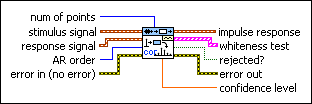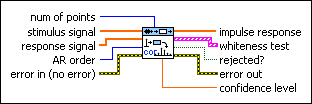Owning Palette: Nonparametric Model Estimation VIs
Installed With: System Identification Toolkit
Estimates the impulse response of an unknown system using the prewhitening-based correlation analysis method and the least squares method. You must manually select the polymorphic instance to use.
Use the pull-down menu to select an instance of this VI.
 Place on the block diagram Place on the block diagram |  Find on the Functions palette Find on the Functions palette |
SI Estimate Impulse Response (Waveform)

 | num of points specifies the number of points for which to compute the impulse response. | ||||||
 | stimulus signal specifies the input waveform of the stimulus signal. | ||||||
 | response signal specifies the input waveform of the response signal. | ||||||
 | AR order specifies the order of the AR model to use to estimate the filter for prewhitening. AR order must be greater than or equal to 0. | ||||||
 | error in describes error conditions that occur before this VI or function runs.
The default is no error. If an error occurred before this VI or function runs, the VI or function passes the error in value to error out. This VI or function runs normally only if no error occurred before this VI or function runs. If an error occurs while this VI or function runs, it runs normally and sets its own error status in error out. Use the Simple Error Handler or General Error Handler VIs to display the description of the error code. Use error in and error out to check errors and to specify execution order by wiring error out from one node to error in of the next node.
| ||||||
 | impulse response returns the waveform of the estimated impulse response of the system. | ||||||
 | whiteness test displays the autocorrelation of the prewhitened stimulus signal and the 99% confidence region. If stimulus signal is well prewhitened, most of the autocorrelation, except the first point, of the whitened stimulus signal will be within the confidence region. If some points exceed the confidence region, especially the second and third points, increase AR order to improve the prewhitening. | ||||||
 | rejected? indicates whether the impulse response estimation of this VI is reliable. If rejected? is FALSE, the impulse response estimation is reliable, and the risk of accepting an incorrect impulse response estimation is 5%. If rejected? is TRUE, the impulse response estimation is not reliable. Increase AR order or redesign the experiment to improve the impulse response estimation. | ||||||
 | error out contains error information. If error in indicates that an error occurred before this VI or function ran, error out contains the same error information. Otherwise, it describes the error status that this VI or function produces.
Right-click the error out front panel indicator and select Explain Error from the shortcut menu for more information about the error.
| ||||||
 | confidence level returns the confidence level of the impulse response. The values of the impulse response between plus and minus confidence level are insignificant, and you can consider them to be equal to 0. |
SI Estimate Impulse Response (Array)

 | num of points specifies the number of points for which to compute the impulse response. | ||||||
 | stimulus signal specifies the input array of the stimulus signal. | ||||||
 | response signal specifies the input array of the response signal. | ||||||
 | AR order specifies the order of the AR model to use to estimate the filter for prewhitening. AR order must be greater than or equal to 0. | ||||||
 | error in describes error conditions that occur before this VI or function runs.
The default is no error. If an error occurred before this VI or function runs, the VI or function passes the error in value to error out. This VI or function runs normally only if no error occurred before this VI or function runs. If an error occurs while this VI or function runs, it runs normally and sets its own error status in error out. Use the Simple Error Handler or General Error Handler VIs to display the description of the error code. Use error in and error out to check errors and to specify execution order by wiring error out from one node to error in of the next node.
| ||||||
 | impulse response returns the estimated impulse response of the unknown system. | ||||||
 | whiteness test displays the autocorrelation of the prewhitened stimulus signal and the 99% confidence region. If stimulus signal is well prewhitened, most of the autocorrelation, except the first point, of the whitened stimulus signal will be within the confidence region. If some points exceed the confidence region, especially the second and third points, increase AR order to improve the prewhitening. | ||||||
 | rejected? indicates whether the impulse response estimation of this VI is reliable. If rejected? is FALSE, the impulse response estimation is reliable, and the risk of accepting an incorrect impulse response estimation is 5%. If rejected? is TRUE, the impulse response estimation is not reliable. Increase AR order or redesign the experiment to improve the impulse response estimation. | ||||||
 | error out contains error information. If error in indicates that an error occurred before this VI or function ran, error out contains the same error information. Otherwise, it describes the error status that this VI or function produces.
Right-click the error out front panel indicator and select Explain Error from the shortcut menu for more information about the error.
| ||||||
 | confidence level returns the confidence level of the impulse response. The values of the impulse response between plus and minus confidence level are insignificant, and you can consider them to be equal to 0. |
SI Estimate Impulse Response (Least Squares Waveform)

 | impulse response length specifies the number of points for which to compute the impulse response.
| ||||||
 | stimulus signal specifies the input waveform of the stimulus signal. | ||||||
 | response signal specifies the input waveform of the response signal. | ||||||
 | error in describes error conditions that occur before this VI or function runs.
The default is no error. If an error occurred before this VI or function runs, the VI or function passes the error in value to error out. This VI or function runs normally only if no error occurred before this VI or function runs. If an error occurs while this VI or function runs, it runs normally and sets its own error status in error out. Use the Simple Error Handler or General Error Handler VIs to display the description of the error code. Use error in and error out to check errors and to specify execution order by wiring error out from one node to error in of the next node.
| ||||||
 | impulse response returns the estimated impulse response of the unknown system.
| ||||||
 | standard deviation returns the standard deviation of the estimated impulse response.
| ||||||
 | error out contains error information. If error in indicates that an error occurred before this VI or function ran, error out contains the same error information. Otherwise, it describes the error status that this VI or function produces.
Right-click the error out front panel indicator and select Explain Error from the shortcut menu for more information about the error.
|
SI Estimate Impulse Response (Least Squares Array)

 | impulse response length specifies the number of points for which to compute the impulse response.
| ||||||
 | stimulus signal specifies the input array of the stimulus signal. | ||||||
 | response signal specifies the input array of the response signal. | ||||||
 | error in describes error conditions that occur before this VI or function runs.
The default is no error. If an error occurred before this VI or function runs, the VI or function passes the error in value to error out. This VI or function runs normally only if no error occurred before this VI or function runs. If an error occurs while this VI or function runs, it runs normally and sets its own error status in error out. Use the Simple Error Handler or General Error Handler VIs to display the description of the error code. Use error in and error out to check errors and to specify execution order by wiring error out from one node to error in of the next node.
| ||||||
 | impulse response returns the estimated impulse response of the unknown system.
| ||||||
 | standard deviation returns the standard deviation of the estimated impulse response.
| ||||||
 | error out contains error information. If error in indicates that an error occurred before this VI or function ran, error out contains the same error information. Otherwise, it describes the error status that this VI or function produces.
Right-click the error out front panel indicator and select Explain Error from the shortcut menu for more information about the error.
|
SI Estimate Impulse Response Details
The Correlation instances of the SI Estimate Impulse Response VI use a finite impulse response (FIR) filter to whiten the stimulus signal and compute the coefficients of the FIR filters from autoregressive (AR) processors. The AR order input determines the prewhitening behavior.
The following figure illustrates the structure of the Correlation instances of the SI Estimate Impulse Response VI. This VI conducts the prewhitening process for the stimulus signal u(k) and response signal y(k) using a pair of identical AR processors.

In the above diagram, Ruy(k) is the cross correlation between the whitened stimulus signal u(k) and the whitened response signal y(k).
 is the standard deviation of the whitened stimulus signal u(k).
is the standard deviation of the whitened stimulus signal u(k).
h(k) is the impulse response of the system.
Examples
Refer to the following VIs for examples of using the SI Estimate Impulse Response VI:
- Estimate Impulse Response VI: labview\examples\System Identification\Getting Started\Nonparametric Estimation.llb
- Glass Tube VI: labview\examples\System Identification\Industry Applications\General.llb
- Hairdryer VI: labview\examples\System Identification\Industry Applications\Mechanical Systems.llb



